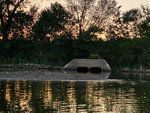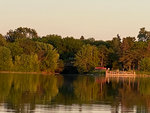
















The Hiawatha Golf Course Master Plan is heading to a public hearing, another meeting in a long line of contentious meetings since the course flooded in 2014 and the public learned how much pumping is being done at the site to keep it dry and playable.
Community members drove to the parks headquarters in northeast Minneapolis to speak about the issue during the public comment period at the Minneapolis Parks and Recreation Board meeting on July 20, 2022.
Standish resident Sean Connaughty has been cleaning up the trash in Lake Hiawatha for years, and served on the MPRB Community Advisory Committee (CAC) that reviewed the issues around the golf course and lake in depth. The Hiawatha Golf Course planning process since 2015 included nine public meetings, seven Community Advisory Committee meetings, and 10 focus open houses. The public comment period for the master plan concluded on Sept. 15, 2020. In public posts online, Connaughty pointed out that a majority of the CAC members appointed in 2015 were golfers, but “a compromise plan” was developed keeping nine holes of golf and the club house and continuing some groundwater pumping, while also making space for water holding, filtering and trash collection.
“Our community’s lake is unsafe and unusable because the city of Minneapolis and the park board are discharging massive and increasing quantities of pollution from golf course pumping and stormwater,” said Connaughty during the public comment period. He pointed out that recently, the park board expressed concern regarding eight pounds of phosphorus being loaded into Minnehaha Creek from the city of Edina near the upscale Bde Maka Ska, while the park board itself puts tons of phosphorus into Lake Hiawatha from turf treatment at Hiawatha Golf Course. “Increasing pollution from golf course pumping has been ignored and unregulated,” said Connaughty.
Later in the board meeting, District 5 MPRB Commissioner Steffanie Musich (who represents the area around Lake Hiawatha) addressed the question: Why don’t we just keep pumping?
“The real big problem is pollution,” said Musich. “When you pump water out of the ground, you are also pumping the nutrients out of the ground.” Water samples in the winter from the golf course pumps showed the same levels of impairment as found in the lake, she explained. “We are adding more pollution to an already polluted system.”
Musich pointed out that when a private parking garage operator was doing something similar, MPRB sued him so that he stopped. “We’re choosing to allow ourselves to continue to pollute. That’s very problematic,” she said.
District 6 Commissioner Cathy Abene addressed the question of why Hiawatha Golf Course is different than what was done at the similarly MPRB-run Columbia Golf Course (located in the Columbia Heights suburb). “This is the golf course in the flood plain. This is the golf course next to the lake with a continuously closed beach.”
MISINFORMATION FROM PARK BOARD
Several people pointed to the language submitted by District 2 MPRB Member Becka Thompson to the board, including Commissioner Musich, and asked that the inaccuracies be corrected.
“The resolution is bewildering,” said Standish resident Matt Ryan. “The numbers don’t make sense.”
Carol Dungan submitted a statement on behalf of the Standish Ericsson Neighborhood Association Board, and then said she had a personal note for the MPRB board members. “I am deeply offended at the way some board members have addressed our community,” she said. “The misinformation coming from this board is unchecked and we deserve better. I would like you to consider giving us an apology for the op-ed that appeared today [in the Star Tribune].”
“I’m appalled at the amount of misinformation,” said Ericsson resident David Dietz, who lives four blocks from Lake Hiawatha, adding this it “further divides us.” He said, “We live in this area and experience the consequences of doing nothing.”
Hiawatha 4 All member Kristen Olsen pointed out that the master plan was developed over years and included public input from the multiple needs of people who use the park. “To insist on 18 holes of golf would mean abandoning not only reduced pumping but pollution treatment and flooding mitigation, as well,” Olsen said. She observed that the plan was developed by the community, and is what community members have asked the board to approve for years. “You owe it to the community to finally take action on this plan,” said Olsen.
On behalf of the Sierra Club Northstar Chapter, Sheila Wiegman said, “We believe these improvements are direly needed for stormwater and water quality improvement.”
BLACK AND DAKOTA HERITAGE
During the course of the meeting, At-Large MPRB Member Alicia Smith (who is also the Corcoran Neighborhood Organization Executive Director), Al Flowers, Jonathan Carlson and Darwin Dean pointed out the heritage of African American players at Hiawatha Golf Course, and said that taking away an 18-hole course was an act of racism.
District 1 Commissioner Billy Menz said, “I have to put aside my ecological values because this is more important.” He stated that he would be voting against the master plan and supports prioritizing 18 holes.
Nicole Cavender, who lives near the lake, spoke on behalf of the Dakota people who have many sacred sites near Lake Hiawatha. She pointed out that Minnesota is the Dakota homeland, and that they have lived in the area for thousands of years. “Why is no one talking about the Dakota people who are still here?” she asked.
“The lake should be treated kindly and respectfully,” stated her six-year-old son, Weston.
MPRB is expected to set a date for the public hearing at their next board meeting on Aug. 3.
Comments
No comments on this item Please log in to comment by clicking here